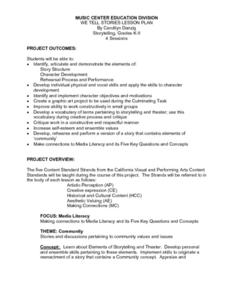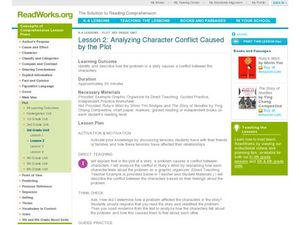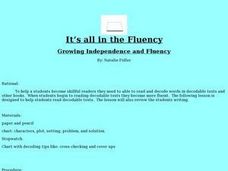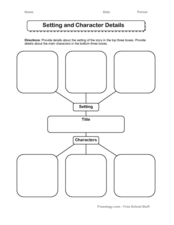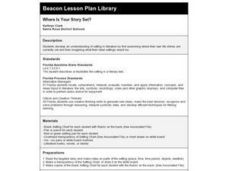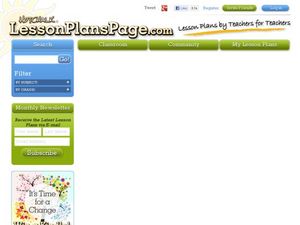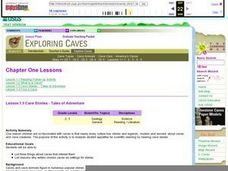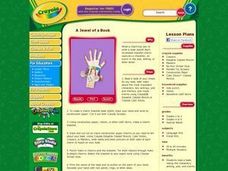Curated OER
We Tell Stories
Young readers bring characters to life by working in small groups to script and perform stories that contain a community concept. Detailed questions and activities are outlined for the class. Consider having your groups create...
Curated OER
Awesome Allegories
Studenets are told that Peter Paul Rubens was born on June 28, 1577, in Siegen, Germany. They create their own allegorical painting, think of a favorite story. Students write a summary of one scene in that story, using Crayola Erasable...
Curated OER
Analyzing Character Conflict Caused by the Plot
How do we know how a character was affected by the conflicts they encounter in a story? We use evidence from the text to make assertions about the characters we read about. Third graders practice finding and using evidence in a...
Curated OER
Set the Scene
Third graders read the story "A Bargain for Frances" and make predictions about the unfolding plot of the story. In this set the scene lesson, 3rd graders examine the three parts of a story; the beginning, middle, and end.
Curated OER
Learning to Analyze Characters
Students discover writing strategies authors use to enhance characters. In this character writing lesson, students are read the Knuffle Bunny books by Mo Willems and analyze the story, characters and settings as they listen....
Curated OER
Introduction to Drama
Introduce your class to drama! You cast each pupil as a different character from a story you have read. They are given a general outline of the scene, act out the scene multiple times, then discuss the weak and strong aspects of each...
Curated OER
Novel Jeopardy
Play a classroom version of the classic game show Jeopardy, to review and discuss the novel your class has been reading. Questions about plot and other story elements are written on cards and given point values. Divide the class into...
Museum of Disability
Ian’s Walk and Apples for Cheyenne
Help young learners understand friendship and empathy with two reading comprehension lessons. Each lesson focuses on a story about a child with autism, and encourages readers to compare and contrast the characters to each other and to...
Teacher's Corner
Dr. Seuss Story Map
Guide young readers through their first book report with a story map designed for a Dr. Seuss book. After your class finishes their story of choice, they list the title, characters, conflict, and other elements of literature on the book...
Curated OER
It's All in the Fluency
Take a trip to the library! Elementary schoolers visit the library and choose books to read independently. They use the cover-up method of deciphering unknown words and use timed-readings to increase fluency. They discuss characters,...
Curated OER
Story Creation Magic: Character, Setting, Plot
Students review the terms plot, setting, and characters and examine how all of these elements are needed to make a story. They are given parts of stories and they try to identify all of those parts of the story.
Curated OER
Setting and Character Details
In this setting and character worksheet, students provide details about the setting and character in this graphic organizer. Students provide 3 details for each.
Curated OER
Character and Plot Development Through Comics
Third graders are introduced to character, plot development, point of view, and tone through the use of comic strips. They, in pairs, identify these four attributes in the comic strip and present their findings to the class.
Curated OER
Where Is Your Story Set?
Students explore the concept of setting in literature by identifying their own current setting, and imagining what their ideal setting would be. They read a piece of literature, identify the setting and record the information on a chart.
Curated OER
Story Elements/ Setting
Students practice the story element of setting. In this setting lesson, students listen to the story Tulip Sees America by Cynthia Rylant. They discuss and describe the places that Tulip saw in the story.
Curated OER
Create - A - Story
Apply the elements of a story to create an original story. They select a character, setting, and plot out of a bag, and write an original story tying the three story elements together.
Curated OER
Lesson Plan 7: The Elements of Story
Budding novelists work on character development by relating to the characters in their stories. They imagine their own hopes and dreams and recall those of characters from books they've read. Learners also consider struggles the...
Curated OER
Chain Together A Book Report
Individuals examine a book's components, including key events, characters, and vocabulary and develop "chain book reports" with their peers. Strips of paper containing the book's important events are staples together and hung.
Curated OER
Writing Scripts
Create a classroom full of writers using this innovative technique. The presentation walks learners through the process of writing a script, including identifying the setting, characters, and major events in the story. After reviewing...
Do2Learn
Story Organizer
Kids can get all their plot points in line by filling out this graphic organizer with information from a story they have read. Pupils note down the title and author, the characters, the setting, and four events from the story.
Curriculum Corner
Fiction Organizer
Teach your youngsters about the elements of plot with this handy graphic organizer. Pupils note down the main character, the setting, the problem, and the solution of any fictional story they read.
Curated OER
Cave Stories - Tales of Adventure
Students list three things about caves that interest them and list reasons why writers choose caves as settings for stories.
Curated OER
A Jewel of a Book
Students read a book, noting the characters, setting, plot, and events. They gather, synthesize, and then select the most important data from their book to prepare a book report by decorating a charm bracelet with pertinent information...
Curated OER
Story Plan Graphic Organizer
In this story planner graphic organizer worksheet, students fill in the genre, characters, setting, plot, complication and resolution before they use the information to write a story. They also list useful words that will be used.
